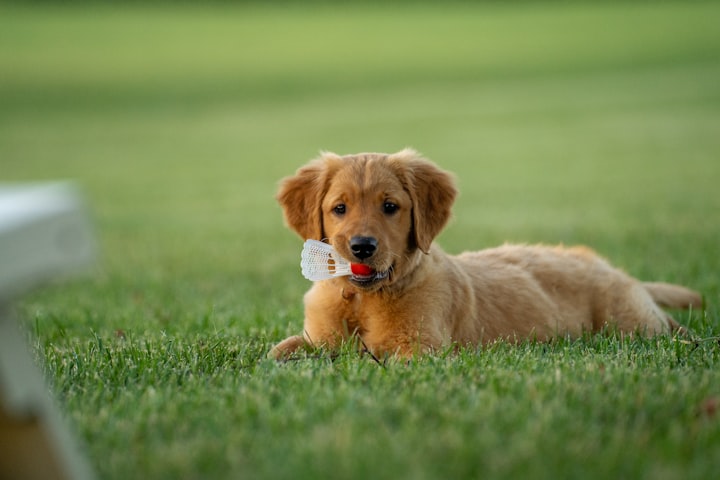Ultimate Guide to Training Your Puppy
From Potty Training to Basic Commands, How to Train Your Puppy for a Happy Life Together

Dog training is an essential part of owning a dog. It helps to ensure that your dog is well-behaved, safe, and happy. Proper training can also help you build a strong bond with your dog and make your life together more enjoyable. In this blog, we will discuss some key aspects of dog training and how to get started.
First and foremost, it's important to understand that dog training is not just about teaching your dog commands or tricks. It's about teaching your dog to behave in a way that is safe, appropriate, and beneficial for both you and your dog. This can include basic obedience training such as sit, stay, come, and heel, as well as training for specific behaviors such as house training, crate training, or leash walking.
One of the most important aspects of dog training is consistency. Dogs thrive on routine and consistency, so it's important to establish clear rules and expectations for your dog and to stick to them. This means using the same commands, rewards, and consequences consistently, and avoiding mixed messages that can confuse your dog.
Another important aspect of dog training is positive reinforcement. This means rewarding your dog for good behavior with treats, praise, or playtime. Positive reinforcement can be a powerful tool in training your dog because it encourages your dog to repeat behaviors that are rewarded, rather than behaviors that are punished or ignored.
Safety: A well-trained dog is less likely to engage in dangerous behaviors such as running into traffic or biting people. Training can teach your dog to respond to commands such as “stay” or “come,” which can help keep them safe in potentially dangerous situations.
Socialization: Socialization is important for dogs to learn how to interact appropriately with other dogs and people. Proper training can help your dog learn to be calm and friendly around other animals and people, which can make them more enjoyable to be around.
Behavior modification: Training can help modify undesirable behaviors such as barking, jumping, or chewing. By teaching your dog appropriate behaviors, you can prevent destructive behavior and make your home a more pleasant place to be.
Bonding: Training can be a great way to strengthen the bond between you and your dog. When you train your dog, you establish trust and communication, which can lead to a deeper relationship.
Mental stimulation: Dogs are intelligent animals that thrive on mental stimulation. Training can provide your dog with mental exercise and can prevent boredom, which can lead to destructive behavior.
Legal requirements: In some places, dog training is required by law. For example, some cities or apartment buildings require dogs to be trained and well-behaved to prevent disturbances to neighbors.
Enjoyment: A well-trained dog is a joy to be around. A dog that is obedient, well-behaved, and responsive to commands can be taken to more places and included in more activities, which can enhance your enjoyment of life.
When using positive reinforcement, it's important to choose rewards that are meaningful and motivating for your dog. Some dogs are highly food motivated and respond well to treats, while others may prefer toys or attention from their owner. It's important to experiment and find what works best for your dog.
In addition to positive reinforcement, it's also important to use humane training methods that do not cause pain or fear in your dog. This means avoiding punishment or aversive training techniques such as shock collars, choke chains, or physical force. These methods can not only be cruel and harmful to your dog, but they can also damage your relationship with your dog and lead to aggression or other behavior problems.
Instead, consider using methods such as clicker training or lure-reward training, which rely on positive reinforcement and encourage your dog to think and learn on their own. These methods can be effective for teaching a wide range of behaviors, from basic obedience to more advanced tricks and sports.
Finally, it's important to remember that dog training is an ongoing process. Even after your dog has mastered basic obedience, it's important to continue training and reinforcing good behavior throughout their life. This can help to prevent behavior problems from developing and can strengthen your bond with your dog over time.
In summary, dog training is an important aspect of responsible dog ownership. By using positive reinforcement, humane training methods, and consistency, you can help your dog learn to behave in a safe and appropriate manner. Whether you're teaching basic obedience or more advanced behaviors, remember to be patient, consistent, and always prioritize your dog's well-being and happiness. With time and dedication, you can build a strong bond with your dog and enjoy a happy, healthy life together.
About the Creator
CarryOnEDC
Giving people knowledge about the importance of being prepared for any situation when there is no help on the way.






Comments
There are no comments for this story
Be the first to respond and start the conversation.